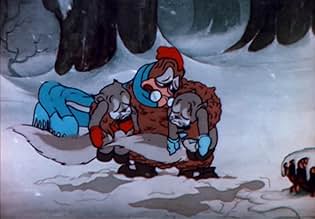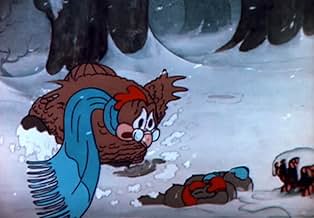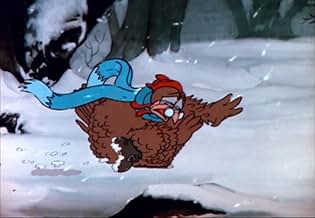In this entry in the MGM "Happy Harmonies" series, a chicken has hatched (at least) seven chicks; she locates six of them, but the other, Eggbert, is lost.In this entry in the MGM "Happy Harmonies" series, a chicken has hatched (at least) seven chicks; she locates six of them, but the other, Eggbert, is lost.In this entry in the MGM "Happy Harmonies" series, a chicken has hatched (at least) seven chicks; she locates six of them, but the other, Eggbert, is lost.
Esther Campbell
- Chicks
- (uncredited)
Beatrice Hagen
- Squirrel Children
- (uncredited)
Dorothy Lloyd
- Hen
- (uncredited)
Mae Questel
- Squirrel Children
- (uncredited)
The Rhythmettes
- Vocalists
- (uncredited)
Jayne Shadduck
- Chicks
- (uncredited)
Ian Wolfe
- Grandpa Squirrel
- (uncredited)
Featured reviews
Love animation, it was a big part of my life as a child, particularly Disney, Looney Tunes, Hanna Barbera, Studio Ghibli and Tom and Jerry, and still love it whether it's film, television or cartoons. With significantly broader knowledge of different directors, animation styles and studios, actually appreciate and love it even more now.
As has been said a few times already, 'The Lost Chick' is fairly typical of Harmon-Ising, leaning towards the cute kind of cartoon with a lot of sentiment in alternative to the laugh a minute and hilarious kind, the latter being the one that a lot seem to prefer (understandably, though am hardly biased against the former). This approach has varied with Ising. In some instances it has been very sweet and charming, in others it can be cloying and too cutesy. Some fit in the former category, others in the latter category. Sadly, 'The Lost Chick' is one of the latter category cartoons.
'The Lost Chick' is not an unwatchable cartoon by all means. It may be underwhelming but there are redeeming values as well. Its best asset is the animation, it's vibrantly and atmospherically coloured and shaded, beautifully drawn and rich in meticulous background detail. The music is another big plus, it's lushly orchestrated, full of charm and character and fits with the visuals beautifully.
There are a few cute and charming moments but they are too few and between
On the other hand, the characters all round are bland and very difficult to endear to, even the titular character, they may have cute exteriors but the antics are easily foreseeable and neither funny or interesting. The story is barely existent and there are times when it drags hard.
Most of 'The Lost Chick' is too saccharine and cloying and some of the distasteful antics render it mostly charmless. Was not expecting a laugh a minute or hilarious cartoon, but 'The Lost Chick' is completely humourless even the sporadic moments that should have amused a little. The moral is laid on too thick and didn't need to be so blatant.
In summation, underwhelming. 4/10 Bethany Cox
As has been said a few times already, 'The Lost Chick' is fairly typical of Harmon-Ising, leaning towards the cute kind of cartoon with a lot of sentiment in alternative to the laugh a minute and hilarious kind, the latter being the one that a lot seem to prefer (understandably, though am hardly biased against the former). This approach has varied with Ising. In some instances it has been very sweet and charming, in others it can be cloying and too cutesy. Some fit in the former category, others in the latter category. Sadly, 'The Lost Chick' is one of the latter category cartoons.
'The Lost Chick' is not an unwatchable cartoon by all means. It may be underwhelming but there are redeeming values as well. Its best asset is the animation, it's vibrantly and atmospherically coloured and shaded, beautifully drawn and rich in meticulous background detail. The music is another big plus, it's lushly orchestrated, full of charm and character and fits with the visuals beautifully.
There are a few cute and charming moments but they are too few and between
On the other hand, the characters all round are bland and very difficult to endear to, even the titular character, they may have cute exteriors but the antics are easily foreseeable and neither funny or interesting. The story is barely existent and there are times when it drags hard.
Most of 'The Lost Chick' is too saccharine and cloying and some of the distasteful antics render it mostly charmless. Was not expecting a laugh a minute or hilarious cartoon, but 'The Lost Chick' is completely humourless even the sporadic moments that should have amused a little. The moral is laid on too thick and didn't need to be so blatant.
In summation, underwhelming. 4/10 Bethany Cox
While Hugh Harman & Rudolf Ising were often seen as Disney copycats and tended to make overly cutesy fodder in their time, they did grow from their usual tricks and make some short films that blended the sentimentality with a hint of cruelty and bitterness. Case in point, The Lost Chick works as a harsh fable about being too playful when you should be working to save yourself.
The primary story of a hen losing one of its eggs that ends up in the hands of two squirrels who think it's a nut establishes this moral from the get go, and while it might be easy to see the payoff coming, it nonetheless demonstrates how harsh of a lesson it is to go against the food you've collected for something you don't know of. The short itself does drag at points as it does spend a bit too much time on the squirrels trying to figure out what to do with the baby chick who hatches from the egg, but once the mother hen comes in to save her baby, the short takes a genuinely dark turn as the squirrels scramble to find food as winter sets in. It's a truly harrowing moment that is nonetheless benefited by a happy ending, but even at that, one could see it as salvation for the squirrels as they don't seem to have a mother or father.
Beyond the content, the art direction suits the late autumn atmosphere beautifully. Despite the short being processed in 2 strip Technicolor (or Cinecolor), the limited palettes allow the backgrounds and character designs to blend in suitably within the grim forest setting. Admittedly, the character designs are a bit unappealing for my tastes as they look cutesified to the point of looking ugly, but one could excuse Harman, Ising and their team as they were still learning how to make workable character designs around this time. That said, the chick itself is a delightful character on its own thanks to its design and movements, and the animators must have had fun making it work as a believable baby chicken that just happened to be animated. Scott Bradley's score is also a delightful contribution as it blends the soothing cute content with harsher melodies and choir gospels strongly.
With all of these contributing factors, The Lost Chick might be one of Harman & Ising's most underrated short films from their Happy Harmony series as it demonstrates their growth into more mature content from their typical slap happy juvenile output beforehand. While Harman himself would use this template for the arguably superior short film The Hungry Wolf years later, there's no denying that through this short, the two men were talented enough to progress beyond their humble beginnings and become admirable animation directors in their own right.
The primary story of a hen losing one of its eggs that ends up in the hands of two squirrels who think it's a nut establishes this moral from the get go, and while it might be easy to see the payoff coming, it nonetheless demonstrates how harsh of a lesson it is to go against the food you've collected for something you don't know of. The short itself does drag at points as it does spend a bit too much time on the squirrels trying to figure out what to do with the baby chick who hatches from the egg, but once the mother hen comes in to save her baby, the short takes a genuinely dark turn as the squirrels scramble to find food as winter sets in. It's a truly harrowing moment that is nonetheless benefited by a happy ending, but even at that, one could see it as salvation for the squirrels as they don't seem to have a mother or father.
Beyond the content, the art direction suits the late autumn atmosphere beautifully. Despite the short being processed in 2 strip Technicolor (or Cinecolor), the limited palettes allow the backgrounds and character designs to blend in suitably within the grim forest setting. Admittedly, the character designs are a bit unappealing for my tastes as they look cutesified to the point of looking ugly, but one could excuse Harman, Ising and their team as they were still learning how to make workable character designs around this time. That said, the chick itself is a delightful character on its own thanks to its design and movements, and the animators must have had fun making it work as a believable baby chicken that just happened to be animated. Scott Bradley's score is also a delightful contribution as it blends the soothing cute content with harsher melodies and choir gospels strongly.
With all of these contributing factors, The Lost Chick might be one of Harman & Ising's most underrated short films from their Happy Harmony series as it demonstrates their growth into more mature content from their typical slap happy juvenile output beforehand. While Harman himself would use this template for the arguably superior short film The Hungry Wolf years later, there's no denying that through this short, the two men were talented enough to progress beyond their humble beginnings and become admirable animation directors in their own right.
I am a huge fan of Hollywood films from the 1930s. I simply adore the movies and shorts and can't get enough of them. There is, however, an exception--most cartoons of the 30s were pretty insipid. Sure, there are some notable exceptions (such as SNOW WHITE), but Disney, Warner Brothers and MGM (among others) insisted on cranking out a huge number of terrible musical films that were just awful. Please understand I am NOT knocking Mickey Mouse or Donald--but the musicals referred to as "Silly Symphonies" (Disney), "Merry Melodies" (Warner) or "Happy Harmonies" (MGM). These cutesy films were pure drivel with practically no humor and no edge--just lots of awful singing and characters so treacly sweet that they are just about unwatchable. The edgy Bugs Bunny or Tex Avery cartoons we know and love today were produced in the following decades. You know it was a bad decade for toons when Popeye and Betty Boop were among the BETTER toons of the age!!! Despite these films being so bad, I recently forced myself to watch a trio of Happy Harmonies shorts. Part of this must be because I am a masochist, but part of it is because I love reviewing the more obscure films--as there is a real scarcity of reviews for older and seldom-seen movies and shorts.
The second cartoon shown on TCM was THE LOST CHICK. While not as rotten as WHEN THE CAT'S AWAY, it was a horrible cartoon if compared to those produced by MGM or Warner Brothers in the 1940s or 50s. There is absolutely no humor or edginess to it--just a lot of "so cute they make you puke" animals running around and singing. The main moral of this tale is "Love Thy Neighbor"--and you see it prominently displayed on the wall of the mother hen's home. Gag me! After seeing it, I felt a very strong need for some Tex Avery to wipe this experience from my mind!
The animation quality, though not great, isn't horrid, so the film manages to barely squeek by with a score of 3.
The second cartoon shown on TCM was THE LOST CHICK. While not as rotten as WHEN THE CAT'S AWAY, it was a horrible cartoon if compared to those produced by MGM or Warner Brothers in the 1940s or 50s. There is absolutely no humor or edginess to it--just a lot of "so cute they make you puke" animals running around and singing. The main moral of this tale is "Love Thy Neighbor"--and you see it prominently displayed on the wall of the mother hen's home. Gag me! After seeing it, I felt a very strong need for some Tex Avery to wipe this experience from my mind!
The animation quality, though not great, isn't horrid, so the film manages to barely squeek by with a score of 3.
Did you know
- GoofsWhen the chick hatches by the fireplace and kicks the shell half, it disappears for a frame then reappears.
- Quotes
Squirrel #1: It's a nut.
Squirrel #2: A nut.
Squirrel #1: It's nothing else but.
Squirrel #2: There's enough food here...
Squirrel #1: ...to last all year.
- Crazy creditsThe ambiguous onscreen statement "A Hugh Harmon - Rudolf Ising Cartoon" has been interpreted as a director's credit.
Details
- Release date
- Country of origin
- Language
- Also known as
- Happy Harmonies (1934-1935 Season) #8: The Lost Chick
- Production company
- See more company credits at IMDbPro
- Runtime10 minutes
- Aspect ratio
- 1.37 : 1
Contribute to this page
Suggest an edit or add missing content























